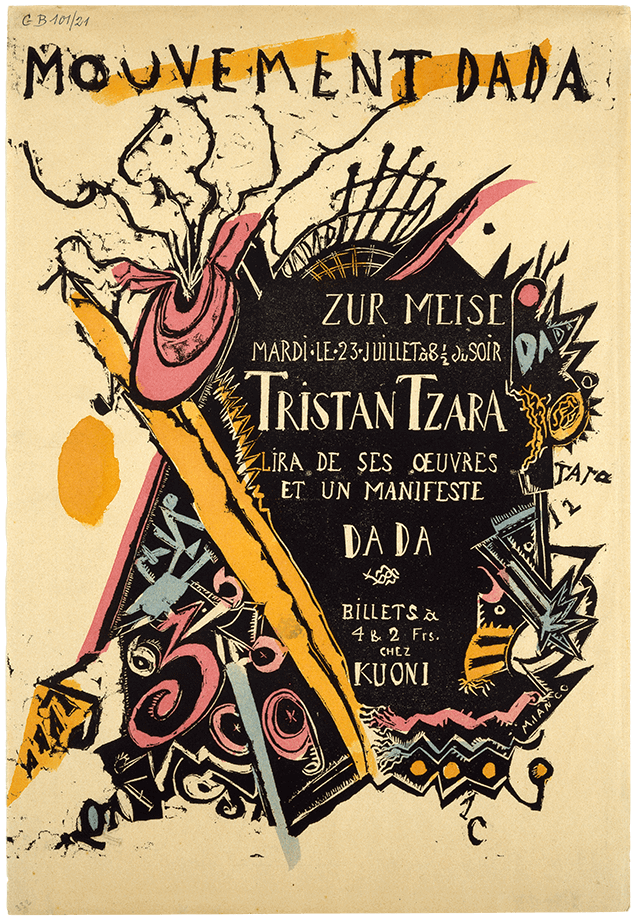Two student friends, Marcel Janco and Tristan Tzara, were stranded in Zurich on their way from Bucharest to Paris due to the turmoil of war. They started a close and productive artistic collaboration there that lasted until autumn 1919, which included, for instance, the Dada journal, the Collection Dada edition, and their lectures on modern, abstract art. Like Hans Richter a portraitist of the Dadaists, Janco made several drawings of his companion. The coloured linocut for the event at the Zunfthaus zur Meisen shows Janco’s masterly artistry and marks a high point in his graphic-art work.
Between summer 1916 and autumn 1919, the Dadaists organized eight soirées, four of them taking place at the Dada Gallery, the others at the guild houses “zur Waag” and “zur Meisen” and in the Kaufleuten Hall. These venues were among the very few in Zurich that could be used for independent public cultural events. The organization of the Dadaist events was very orderly, with advance ticket sales through official agents like Kuoni and Hug and loans of a grand piano or a harmonium from well-known respectable instrument dealers.
On a Tuesday evening in midsummer 1918, Tristan Tzara organized a soirée in which he took the stage alone. He had become better and better at making himself the center of attention. “Advertising and business are poetic elements, too.” At the Zunfthaus zur Meisen he recited poems whose “fragmentary line-up of images and sounds from widely dislocated areas of thought” according to the Züricher Post sounded as follows:
“Says, My head is empty like a brothel cupboard (which you believe him)
Says, My heart is submerged in a newspaper (which you wouldn’t notice)
Sighs, The hearts and eyes are rolling around in my mouth (how disgusting!)”
These literary bits and pieces gave the forty-people audience no reason for commotion or protest, nor did the pointed Dada arrows shot in the recited manifesto (Manifeste Dada 1918), naturally a Dadaist literary genre par excellence:
“Every product of disgust that is capable of becoming a negation of the family is dada; protesting with clenched fists one’s being solely bent on destruction: dada; acquaintance with all the means hitherto rejected by the sexual prudishness of easy compromise and good manners: dada; . . . the abolition of memory: DADA; the abolition of archaeology: DADA; the abolition of prophets: DADA; the abolition of the future: DADA; the absolute and irrecusable belief in every god that is an immediate product of spontaneity: DADA . . .”
Held in French—as was often the case with Dada Zurich—the lecture may have shrouded the Dada spirit in a fog of incomprehensibility, and the fact that the soirée nevertheless passed off in peace and quiet was mainly due to a culturally interested friendly audience. Tzara who in his Chronique zurichoise recounted things being thrown onto the stage apparently took the poetic license to amplify its scandalizing effect after the event in order to create publicity for the international launch of the Mouvement Dada which he was aiming for.
Edition: less than fifty. Printed on thin paper. Signed “M. Ianco” bottom right of plate. Stencil-coloured by the artist, with a different colouring for each copy. Provenance: The poster was purchased by the Kunsthaus Zürich at the auction “Items from the Library and Collection of Tristan Tzara (Kornfeld & Klipstein, Dokumentations-Bibliothek III, Bern)” in 1968.
→ Dada 3, DADA III:33:3
→ Marcel Janco, poster design for Chant nègre [Negro Song], Z.Inv. 1980/42

